Lt. Dan Ferrucci helped escort a non-violent protest to honor George Floyd, and launch a local conversation about racial injustice, from the Green to the steps of Waterbury City Hall.
Story By Gabriel Pietrorazio
Photographs By John Murray
Waterbury was shaken to its core on May 31st by a series of protests; one sanctioned, and three that were not, in the aftermath of George Floyd’s murder by a Minneapolis policeman.
It all started simply enough with a message on Instagram between two friends 48 hours before the first protest. Jalia West and Alexa Eason, both recent college graduates, wanted to organize a non-violent protest in Waterbury to honor George Floyd, and begin a local conversation about racial injustice.
With a megaphone in hand, West kickstarted the demonstration Sunday at 10 a.m.. More than a thousand people descended into the heart of Waterbury for the protest, many with home-made signs raised above their heads.
Starting with a song dedicated to peace, a somber moment lingered in the air as demonstrators stood around the clock in the center of the Green.
Immediately after the song ended, West asked for a moment of silence “to honor those that suffer from systemic racism, and to honor those who we didn’t see on video, but it happened.”

Protesters brought hundreds of homemade signs to the Green.
With a circling sea of bodies engulfing West, she stood on the marble steps of the clock monument and welcomed protesters under grim circumstances.
“I have lived here my whole life,” West said. “I felt that it was right to be a part of the change in our city, state and country. Thank you to those of you that came out. We know representation happens in numbers.”
In her opening remarks she acknowledged Waterbury Police Chief Fernando Spagnolo and Mayor Neil O’Leary for “providing acceptance of what we are doing here.”
Following the offering of an opening prayer, West asked demonstrators to take three deep breaths to calm themselves in preparation for a productive nonviolent protest.
West acknowledged that race was at the crux of George Floyd’s murder. “Before anything,” West said, “I’m a black woman. When you look at me, you do not see my résumé. You do not see that I am a 2020 college graduate of the University of Connecticut, that I have contributed to the community through service and leadership. You only see that I am black woman.”
Alexa Eason is a recent graduate from Georgetown University with a degree in African American studies, and hopes to become a civil rights attorney. Eason assisted in organizing the demonstration in tandem with West, and she took the megaphone to speak about the history of racism.
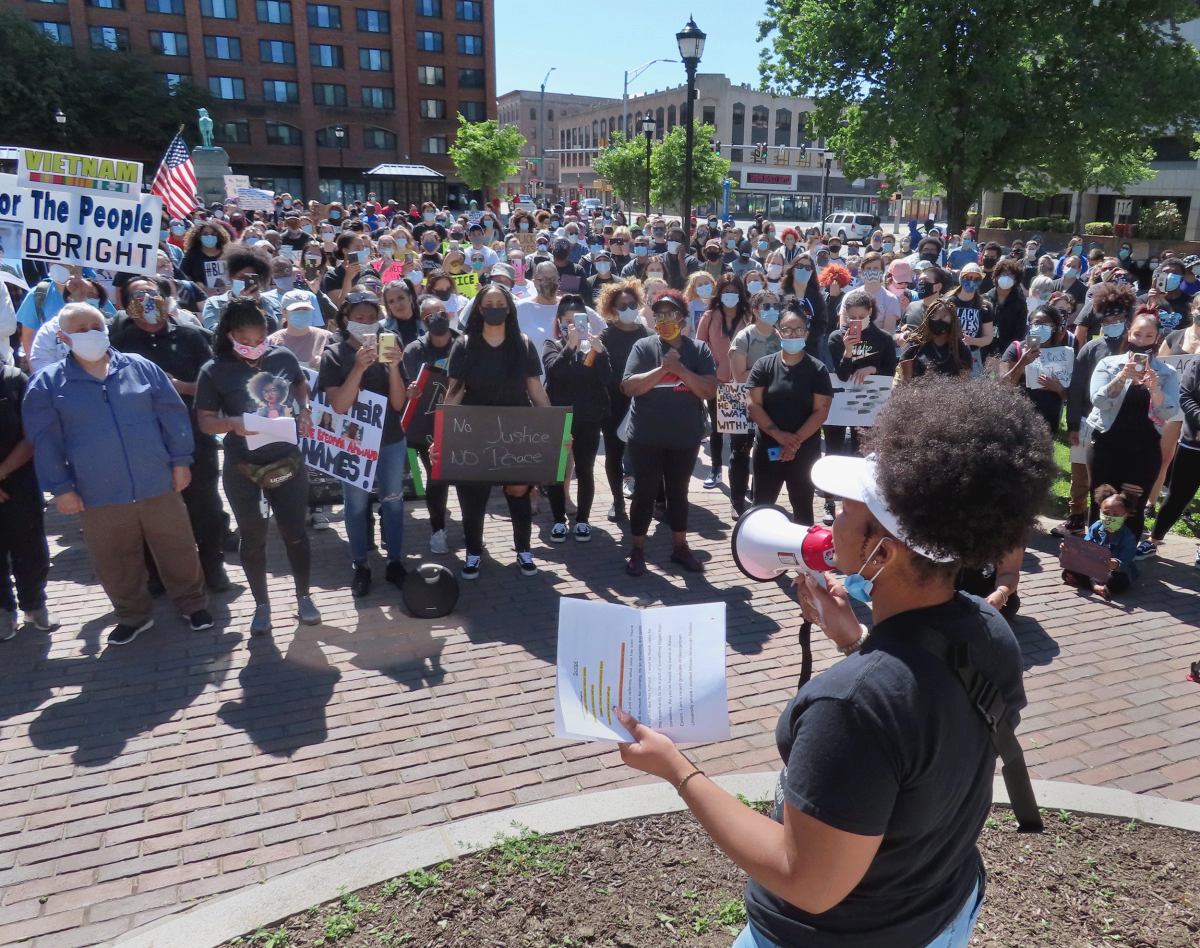
Alexa Eason addressed the crowd shortly after 10 on Sunday morning.
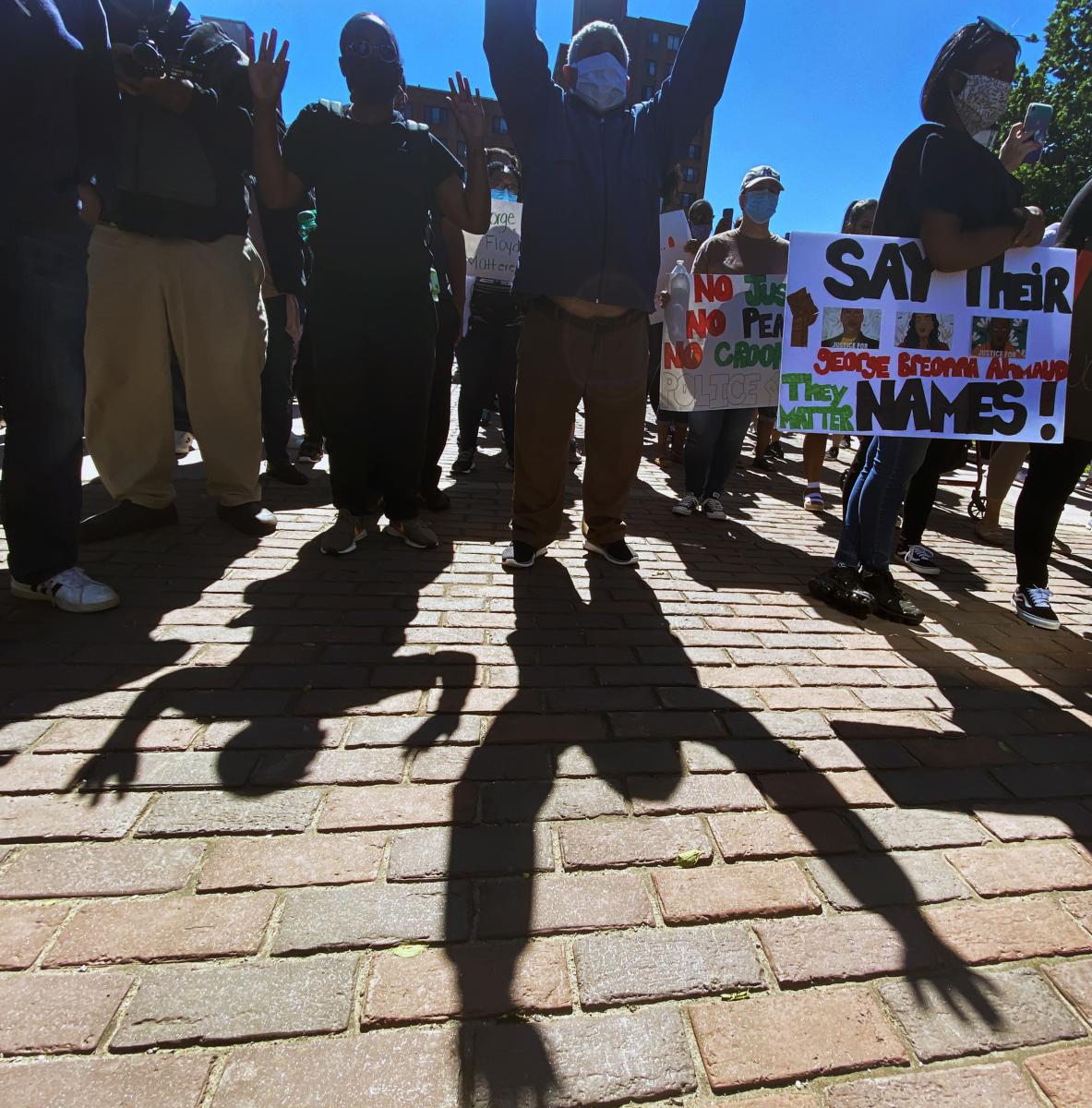
Several protesters held their hands aloft during the entire protest.

The more than 1000 protesters were diverse, and many came in from the suburbs to express solidarity.
“Systemic oppression is stitched into the very fabric of this country.,” Eason said. “We are here because in 2020 black people should not have an implicit fear because of the color of our skin. Black people should be viewed as people, as humans, as equals, and we are not.”
State Representative Geraldo Reyes climbed atop the base of the clock monument and encouraged protesters to work with elected officials to legislate change. Reyes is the vice-chairman of the Black and Puerto Rican Caucus in Hartford and promised to champion a police accountability bill that has been debated the past few years at the capitol.
Reyes took heat from local police two years ago when he was a vocal advocate for police accountability. The bill didn’t pass in 2018, but Reyes said the issue still needs to be addressed.
“I’m not saying that to be combative,” Reyes said, “but we are not fools. We know what our ears have heard, our eyes have seen. We know how we feel in our hearts. Things are not right.”

State Representative Geraldo Reyes Jr. addressing the crowd.
In the 2020 legislative session Reyes has pushed for stronger enforcement of an existing environmental justice law, legislation that protects vulnerable inner-city populations from carrying the excessive burden of toxic dumps in their neighborhoods. Reyes represents the South End neighborhood where there are 16 toxic industries, and the 06706 zip code has the worst air quality in the state of Connecticut.
Long term exposure to toxins weakens immune systems and makes entire populations more vulnerable to health issues, including COVID-19. Across the country black and brown people are dying from the virus at disproportionate rates.
“Go home and Google the words environmental justice,” Reyes said. “You need to understand that this is part of systemic racism.”

Reyes is a champion of police accountability and environmental justice law.
Reyes told the protesters that, “I love what I see here. Every race is represented, and I love that. Waterbury pride.”
Reyes acknowledged the historic protest, but said, “this is just the first step.” He then turned to West and Eason and said, ‘Young ladies you are onto something. Now take this to your government, meet with the mayor, and ask for the next step. What would you like to change? What would you like to see better?”
The protesters then followed West and Eason on a march from the Green to Waterbury City Hall where there were more speeches and songs.
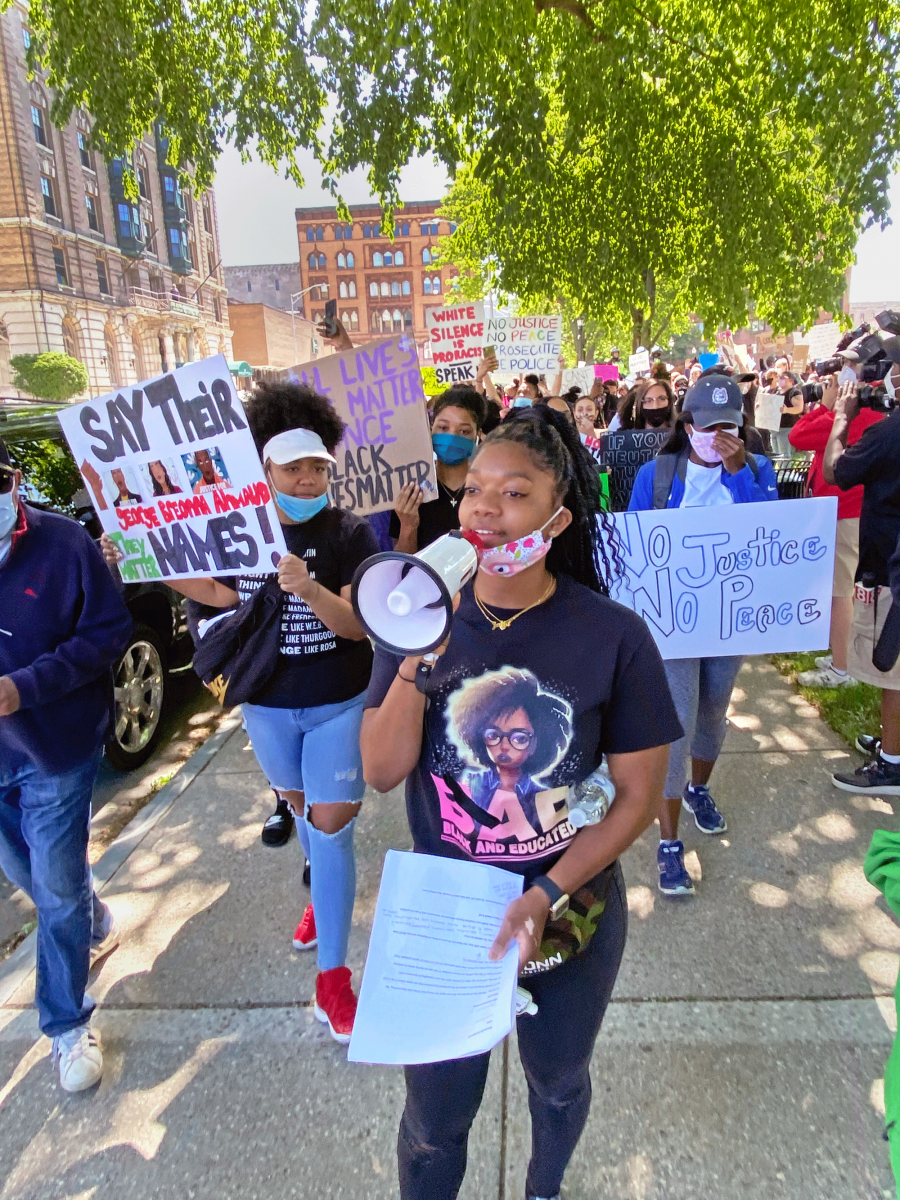
Jalia West, front, and Alexa Eason, left, led the march to Waterbury City Hall.
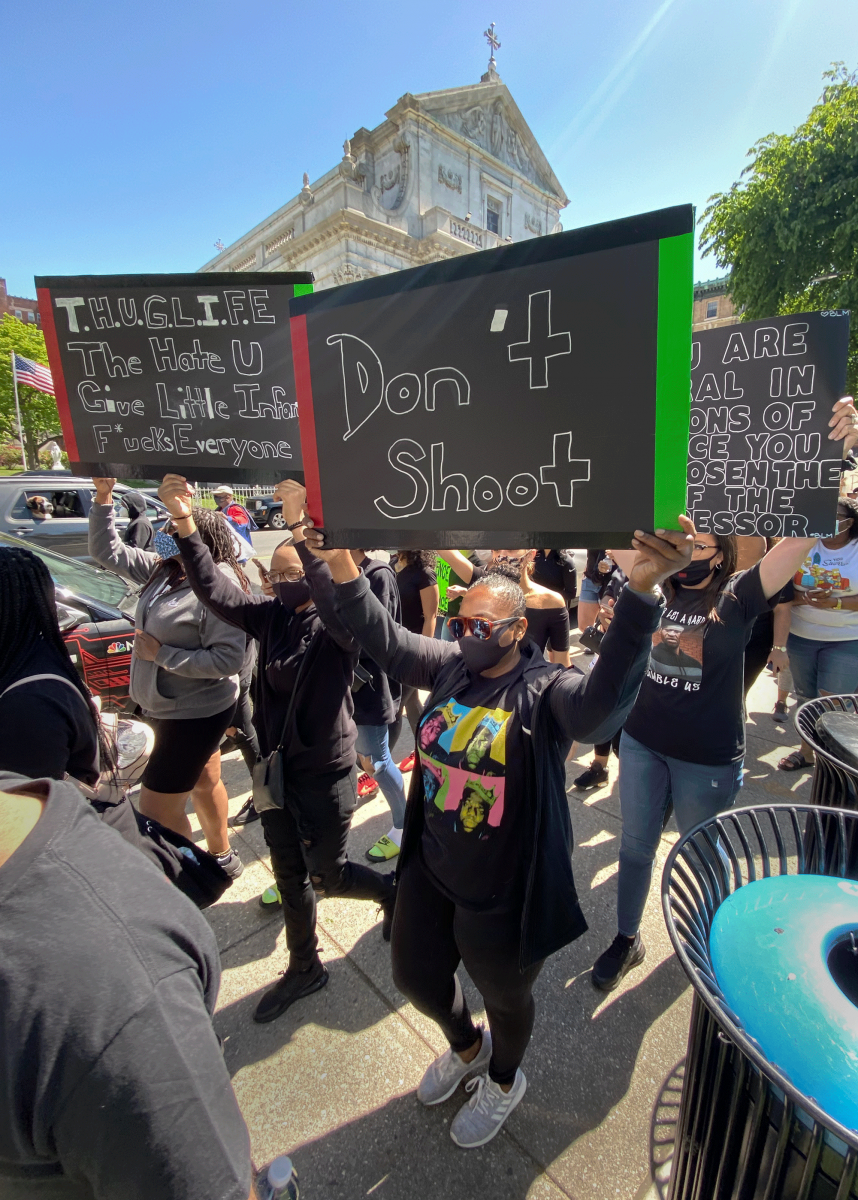
The protest was organic and well attended by Waterbury residents.
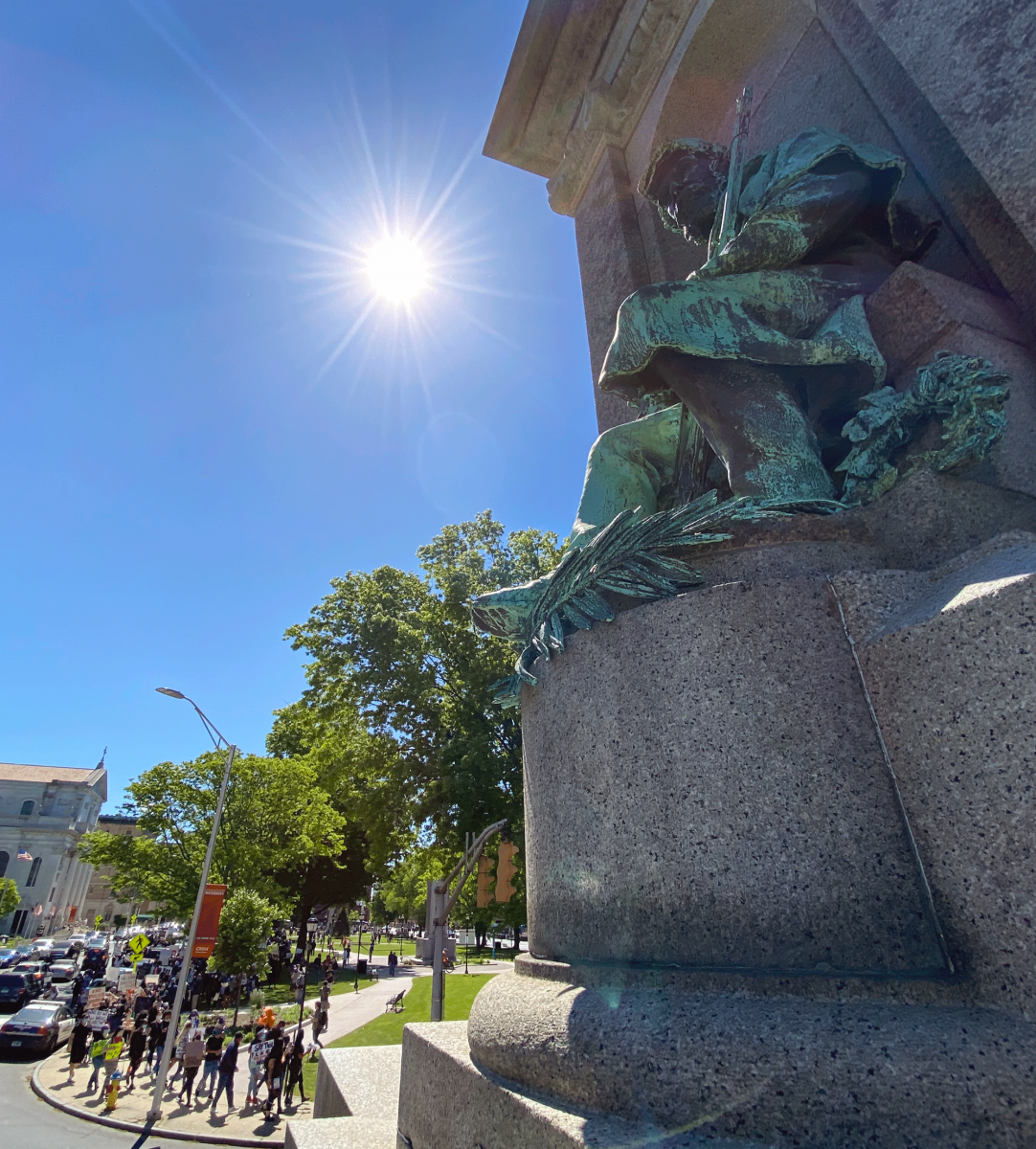
Protesters marched beneath the Soldier’s Monument dedicated to the union soldiers from Waterbury who fought and died in the Civil War.
Community organizer Ronney Morales said, “even though the conflict sprung up miles away in Minneapolis, this one hit home for us.”
Morales talked about the importance of messaging, and how the Waterbury Republican-American newspaper published a picture from a riot scene in Minneapolis as a part of an announcement about the event. Morales was upset at the violent photograph being linked to the protest, as were many others in attendance.
Morales deescalated the tension being voiced among demonstrators and reminded them that this protest would not devolve into acts of violence and vandalism.
“Let’s keep it positive,” Morales said. “If we become negative, we prove them right.”

Ronney Morales asked the entire crowd to take a knee, and most did.
While cities across the nation have descended into looting and riots, Ronney Morales condemned these acts, and emphasized that such deeds would not be condoned in Waterbury.
“I see riots going on around the world,” Morales said, “and that shit ain’t cool. At the end of the day this is how you do it. If you keep looting, rioting, ruining black-owned businesses that came up from the bottom, then what are we telling our kids? They’ll be fighting a worse battle in the future. Stay humble. Stay positive. Give thanks for your life here every day.”
Reverend Edward Jackson Jr., a local pastor at the Ingathering Pentecostal Church shared his thoughts on Floyd’s death, and what this tragic moment means for Waterbury.
“I’m supposed to be teaching Sunday school on Zoom,” he said. “but how can I be on Zoom trying to teach a Sunday school class when my people are dying in the streets?”
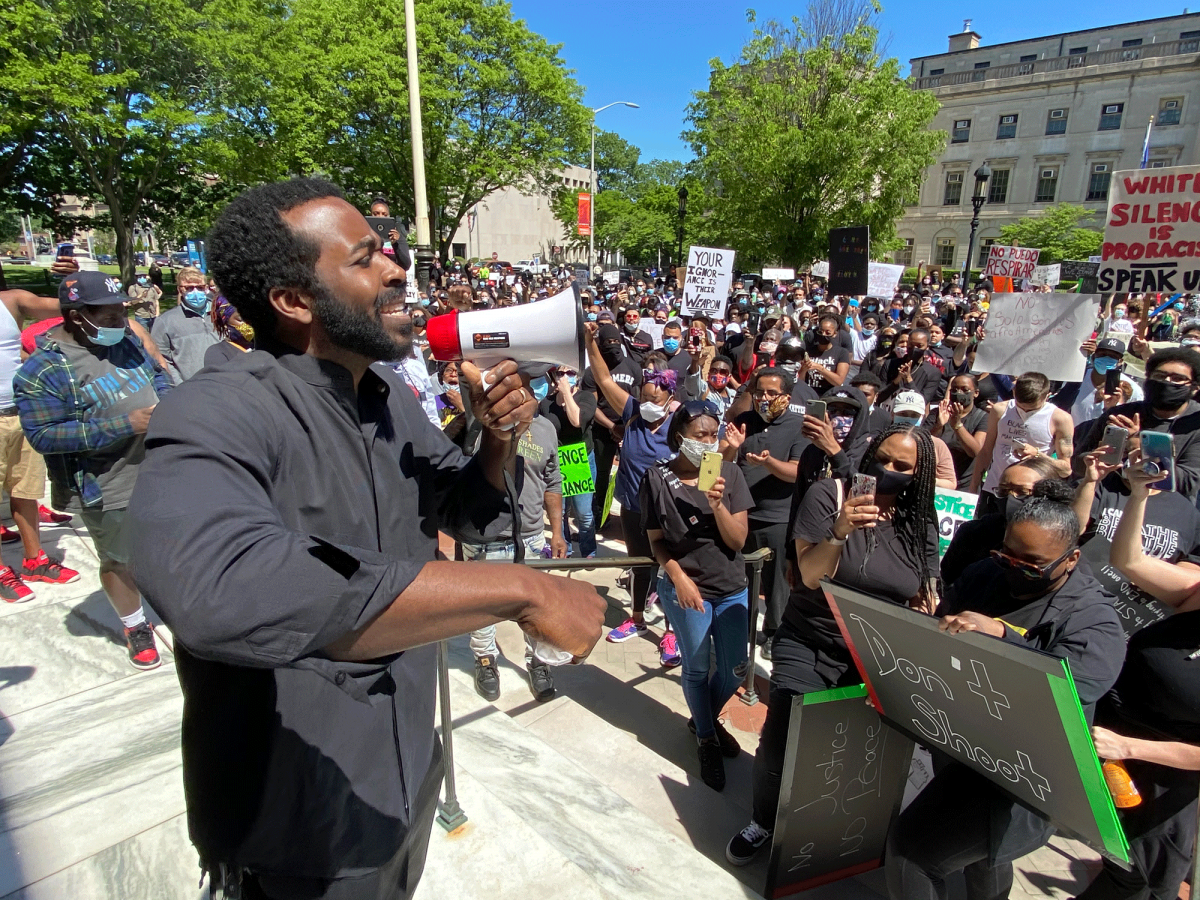
Reverend Edward Jackson gave a passionate speech on the steps of City Hall.
Jackson was animated and passionate as he paced the steps at the entrance to City Hall. “I grew up in these streets,” he said. “I was a victim of police brutality right here in this city. This is not ground zero of what happened to George Floyd, but it’s happening all over the world.”
In the middle of grieving, collective pain and heartache, Rev. Jackson said that the people of Waterbury were all hurting this morning, and he vocalized their frustration for all to hear.
“Everybody knows how we feel,” Jackson said. “They know we’re angry. They know we’re mad. They know we’re confused.”
Rev. Jackson encouraged the good police officers to step forward and speak-up against racism in an attempt to oust bigotry and hatred.
“We want to hear from the good police officers,” he said, “those who allow the racist police officers to do what they do and stay silent so you can collect your six-figure income that we pay for as taxpayers.”
Rev. Jackson then asked a two-part question as Waterbury police officers stood on the outskirts of the crowd in front of City Hall.
“Are you with us?” he asked. “Or are you here to police us? Because there’s a difference.”
Jackson asked officers to stand as allies, and not in opposition to the movement.
“We want you to stand with us. Not against us,” he said. “We don’t need you to police us. We need you to stand with us.”
Several times at the protest the crowd kneeled together as a reminder of Floyd’s fatal encounter with the Minneapolis Police Department.
But whether kneeling or standing, shouting or singing, the sole purpose of this demonstration, Jackson said, was love.
“We’re out here to love,” he said. “We’re not out here trying to promote violence. We’re not out here trying to promote negativity. We want the same respect that you feel like you deserve just because of the color of your skin.”
In closing, Jackson had a message for advocates of All Lives Matter, “All lives may matter to us,” he said, “but until black lives matter to you, our lives don’t matter.”

Latuan Gainey’s mother made sure protesters knew allegations of police brutality exist in Waterbury.
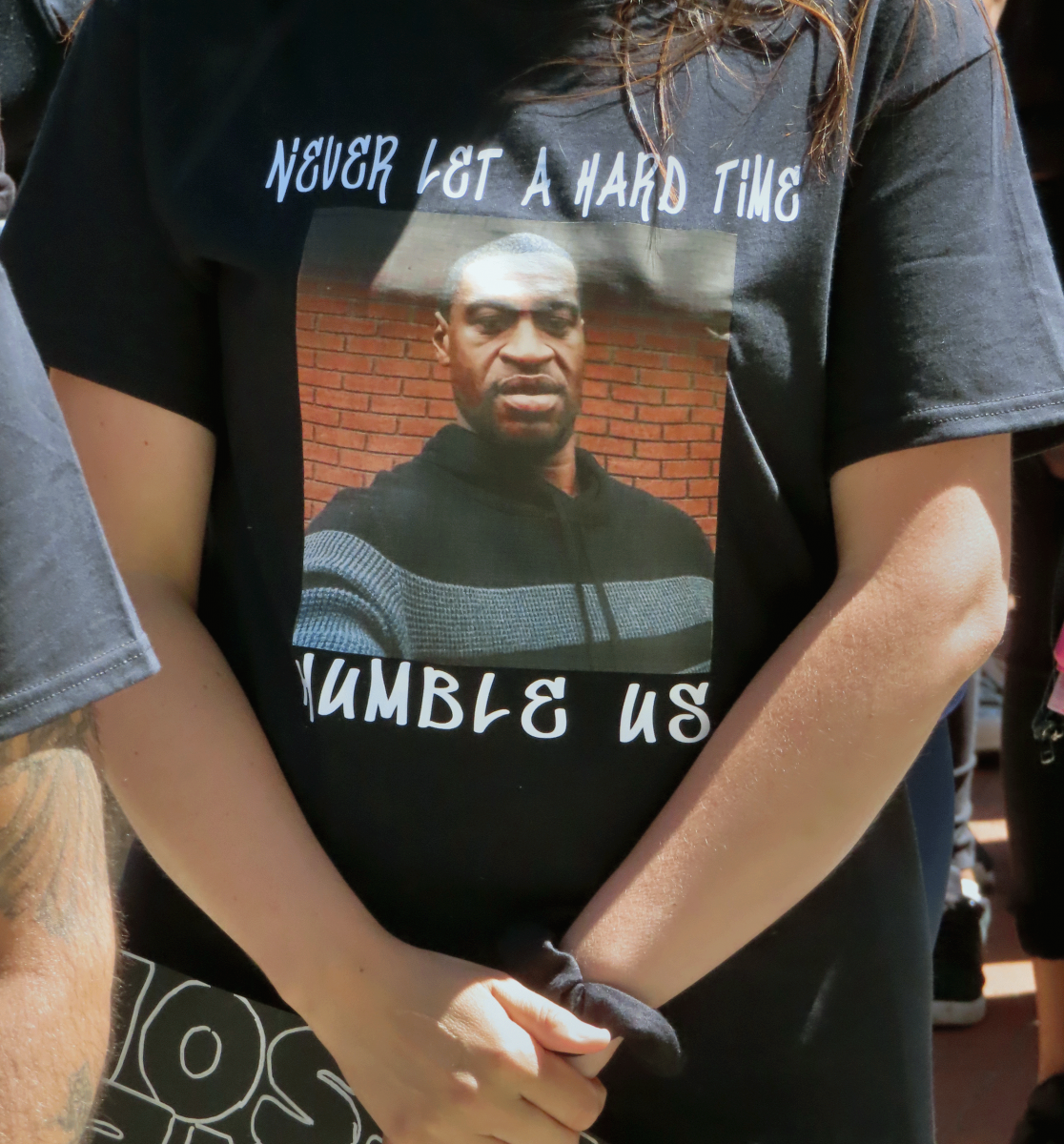
The murder of George Floyd has uncorked worldwide protest against systemic racism in America.
Other speakers shared the megaphone, including a New Haven resident whose cousin, Malik Jones, was killed by an East Haven police officer in 1997 while riding in a stolen car. West implored protesters to support black-owned businesses, especially during the COVID-19 pandemic.
“We need to step it up,” West said. “We have to support each other because if they’re not going to support us, we have to do it for ourselves.”
She asked demonstrators for civic engagement on multiple fronts by participating in the 2020 U.S. Census, and voting in elections across the board, especially in the upcoming presidential election.
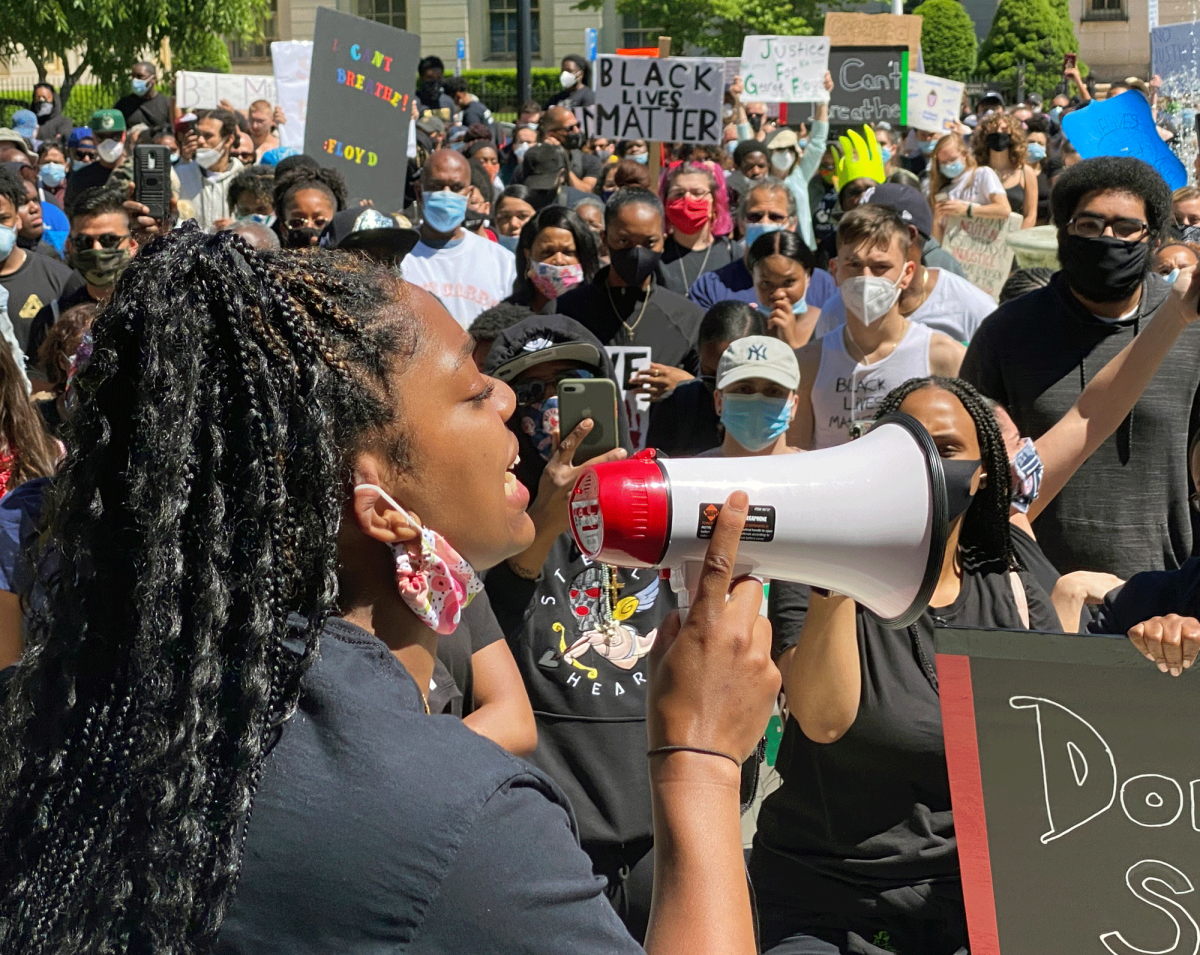
Jalia West on the steps of Waterbury City Hall.
West criticized President Donald Trump for not publicly responding to the death of Floyd. As chants of “four years” rung in the background, West shouted, “You’re only going to have this power for so long. One day you will be answering to the man above, and I’ll be praying for you.”
West pleaded for demonstrators to hold everyone accountable at all times, especially asking police officers for accountability.
“Hold your (police) partners accountable, and if you’re a racist,” she said, “turn in your damn badge.”
In her closing message West said police officers who break the law need to be held accountable. “Don’t just fire them,” she said, “put them in jail like you put us in jail so easily.”
Demonstrators then walked back to the Waterbury Green where the protest formally concluded, or so it seemed.
Minutes after she concluded her non-violent protest, a group of out-of-town activists instigated a march to the Waterbury Police Department on East Main Street.
“Specific organized people hijacked the high energy and emotion of the crowd,” Chief Spagnolo said. “The dynamic changed, the mission changed, and the physical membership of the group changed. The crowd tripled from the march to City Hall to the march back to the Green. And the tone shifted.”
Jalia West spoke to the protesters at the police station and implored them to disperse and remain non-violent. Some broke away and went home, and many others followed instigators and marched towards I-84 to occupy the interstate highway. Confronting the police and occupying the highway appears to have been methodically organized as similar events took place over the weekend in New Haven and Hartford and Bridgeport.
As the crowd marched down to the Brass Mill Commons, Chief Spagnolo and West tried dissuading protesters from flooding up the grassy hillside and onto I-84.
“We were able to convince a group of people to turn back,” Spagnolo said. “Some went back to the Green, some went home, and many went onto the highway.”

Outside agitators seized the momentum of the protest to lead hundreds of people up onto I-84 to close down the interstate highway. Photograph by Gabriel Pietrorazio
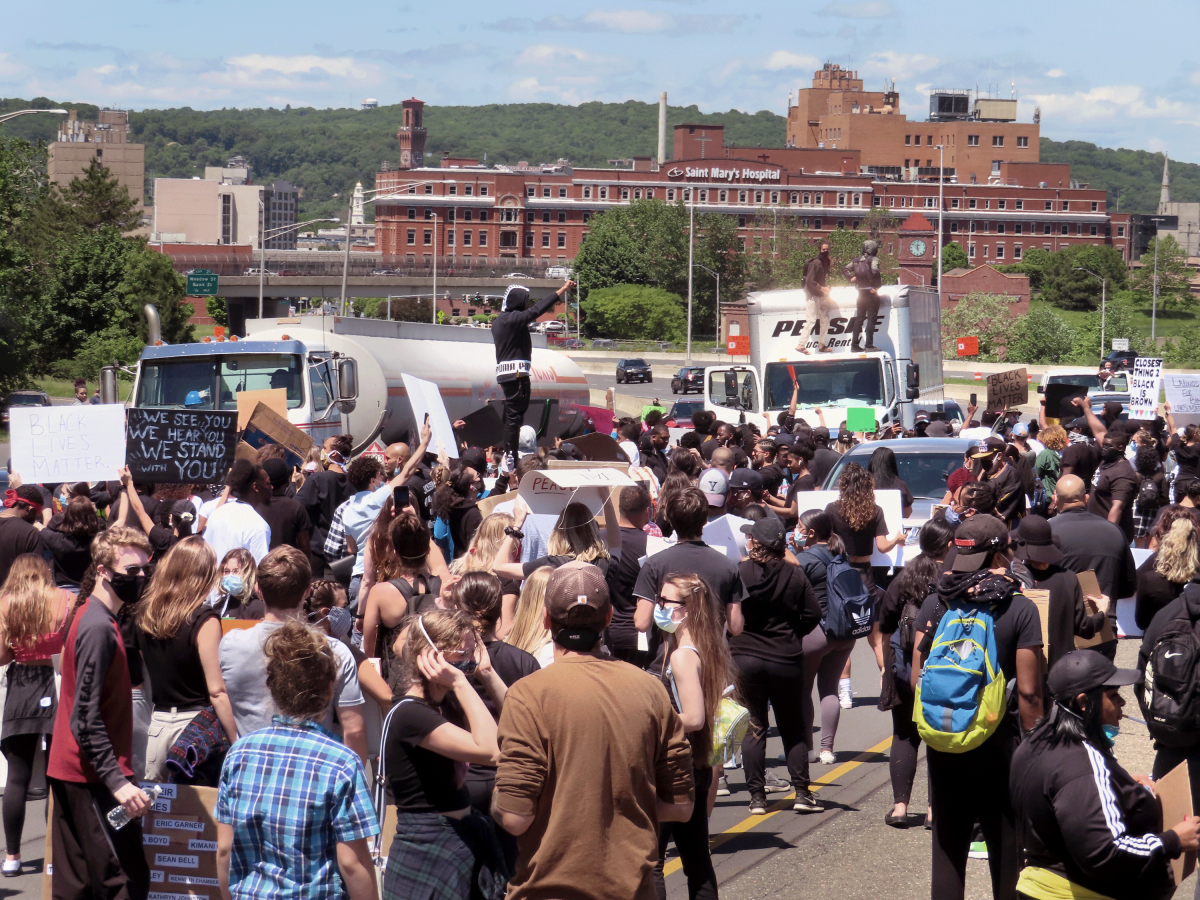
Horns beeped, protesters celebrated, and despite the chaotic scene the mood was upbeat and joyous.
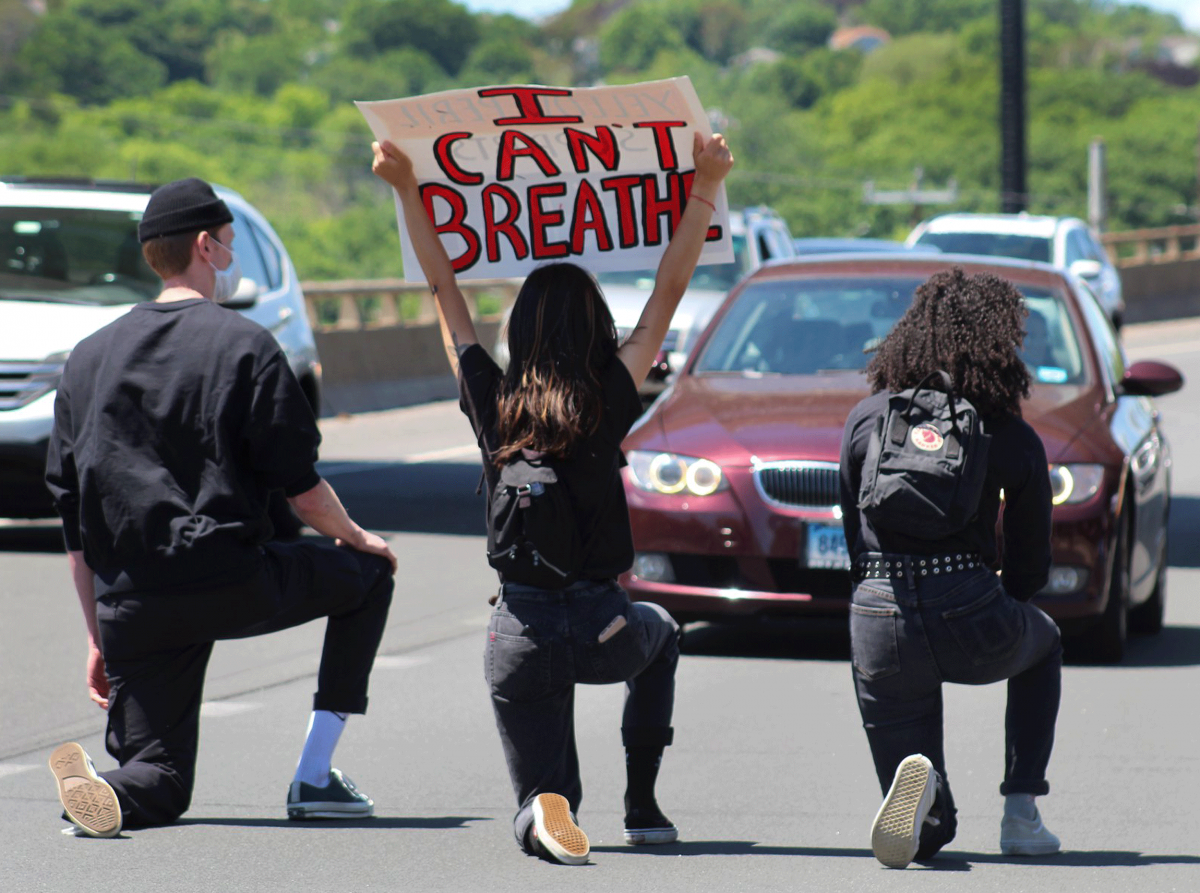
Motorists stopped and waited patiently for 40 minutes until the protesters marched off of the interstate. Photograph by Gabriel Pietrorazio
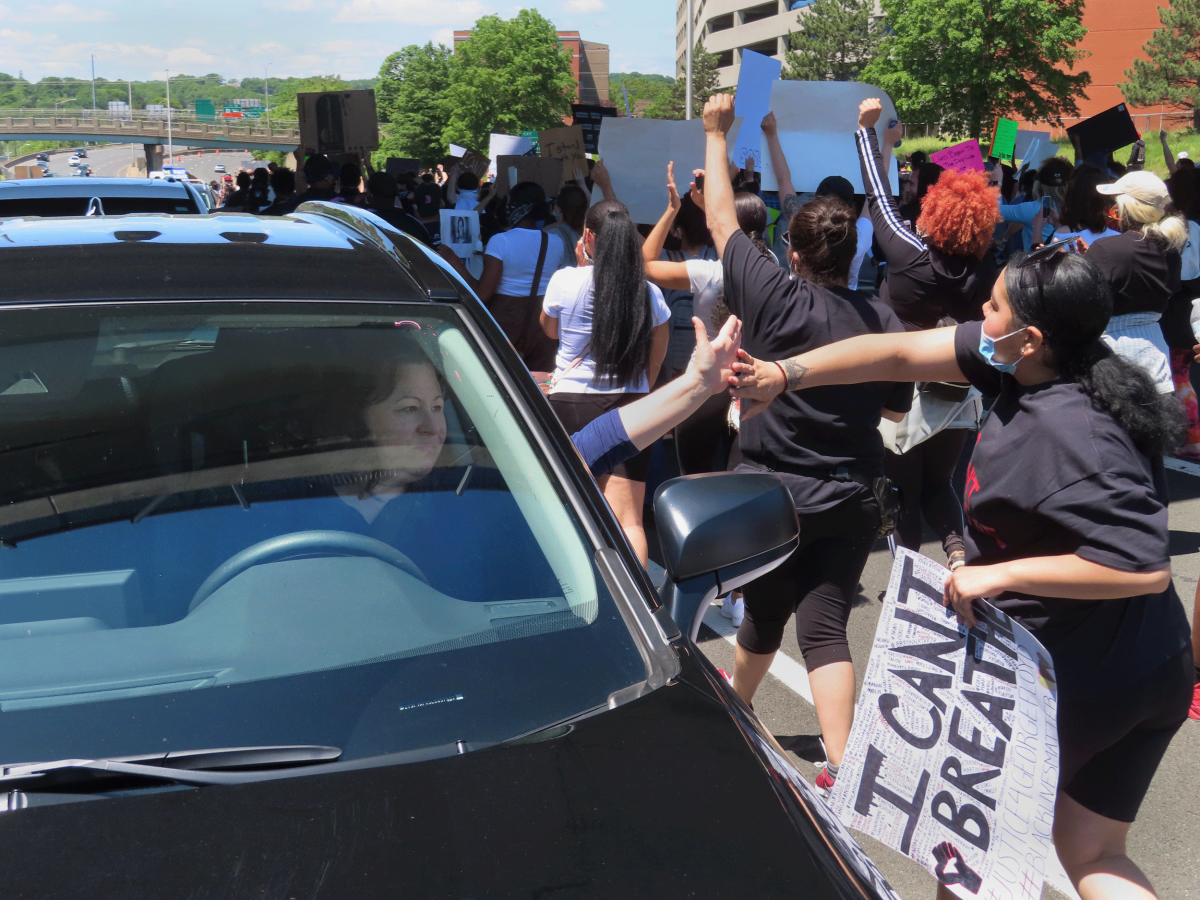
Motorists understood the historic moment and many expressed solidarity with the protest.

Several black truck drivers gave protesters permission to climb up on their rigs.
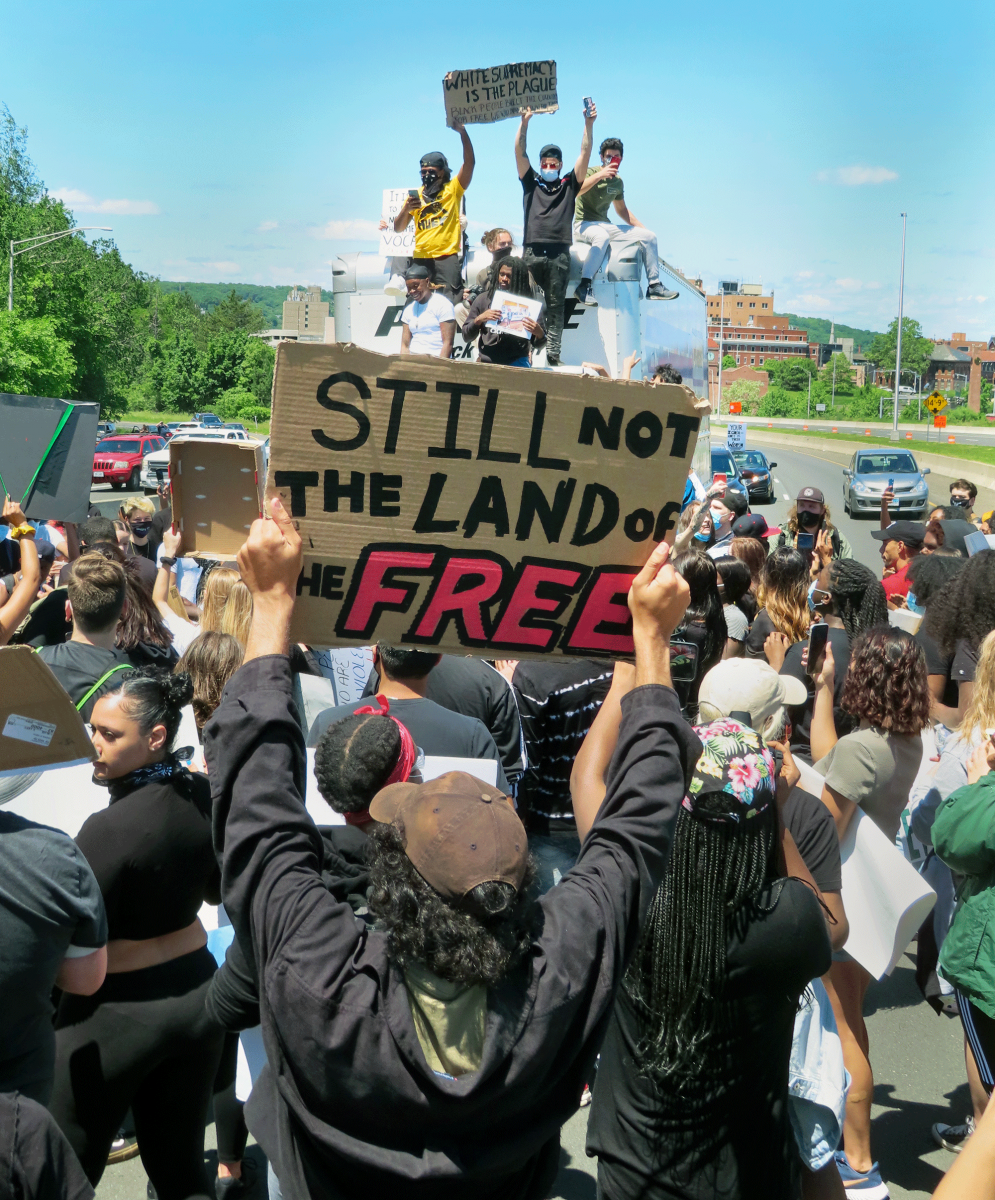
For many closing down an interstate was a moment of celebration.
The event Jalia West had organized in 48 hours had been flawless, but organizers from outside of Waterbury capitalized on the raw emotion of the crowd and steered them towards confrontation.
“We were not familiar with the people leading the group to the highway,” Police Chief Spagnolo said. “They were not part of Jalia West’s event.”
Spagnolo said many Waterbury residents got caught up in the negative agitation and followed an organized group of outsiders onto I-84. “I understand the anger and empathize,” Spagnolo said. “Most protesters from Waterbury had good intentions on Sunday, but many were taken advantage of by outside agitators looking to incite. Everything that happened after Jalia West’s event was organized by someone else, and it happened in Bridgeport, New Haven and Hartford.”
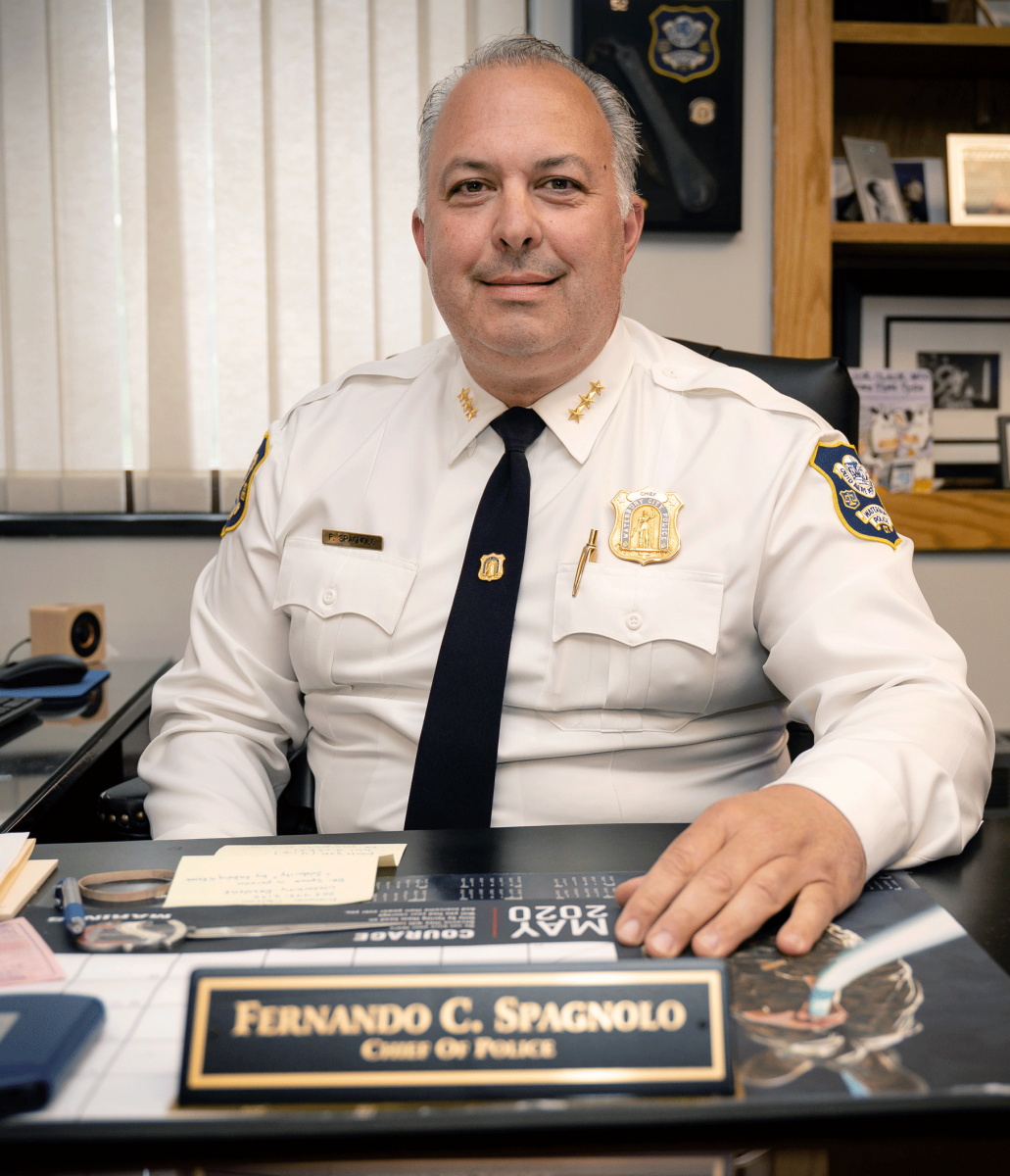
Waterbury Police Chief Fernando Spagnolo. Photograph by Felix Rodriguez
While hundreds of protesters shut down I-84, Jalia West went to her car and broadcast on Facebook Live.
“The second protest has nothing to do with me,” West said, clearly distraught at the day’s turn of events. She implored that if anyone listening knew someone on the highway, that they needed to call them, and tell them to stop.
“Those that are upset and taking their anger out in ways that don’t demonstrate what I came here for,” West said, “its hurtful.”
The actions of outside agitators leading the second protest did not exemplify West and Eason’s intent of a non-violent protest. West told anyone listening to her on Facebook Live that the takeover of the highway proved critics right.
“That’s what they expect out of you,” she said.
The day before doubt had spread across social media questioning whether the people of Waterbury could organize a peaceful demonstration right in their own backyard.
“They said there’s no way we could have a non-violent protest here in Waterbury,” West said. “People were going on the Waterbury Observer and Republican American (pages) and commenting how there’s no way this could be a peaceful protest, but it was. It was not violent. What was organized went how it should.”
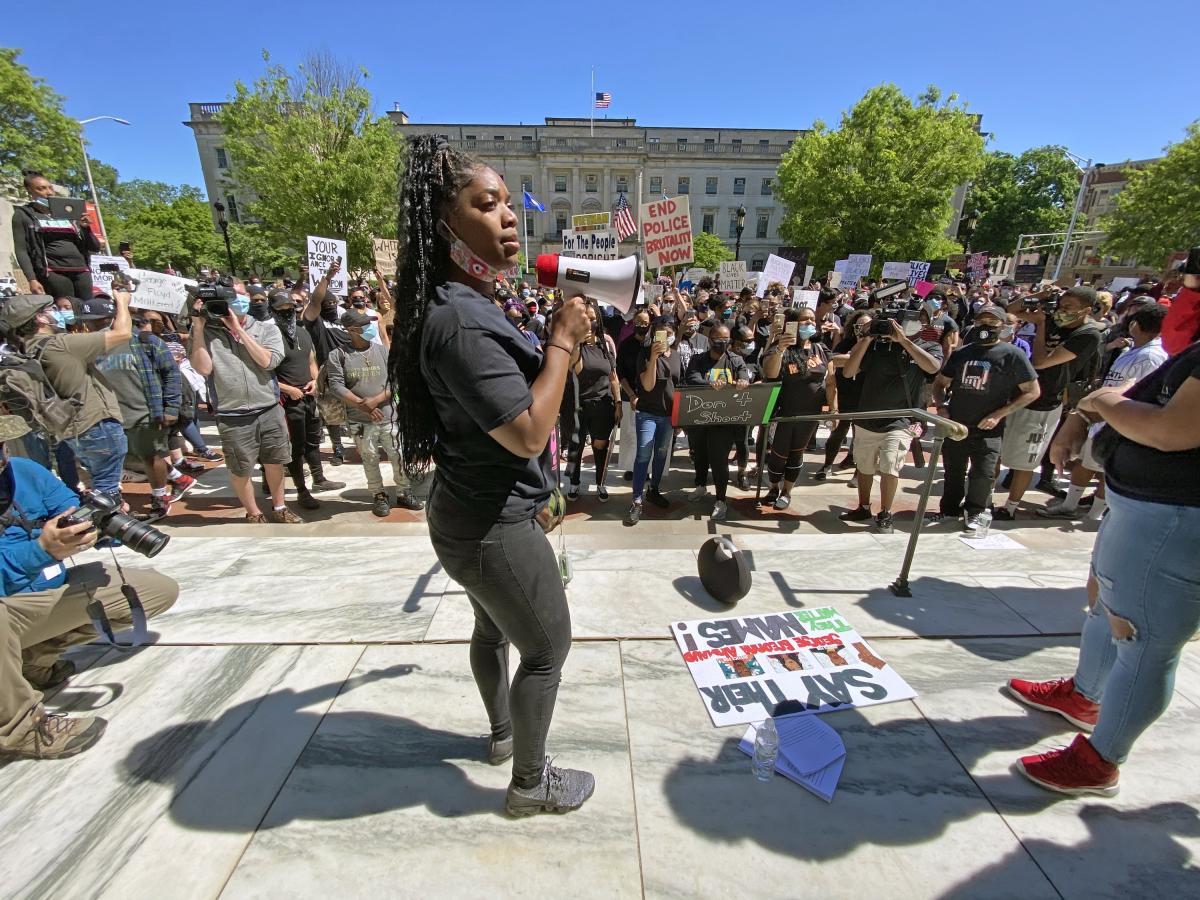
This was Jalia West’s first attempt at organizing a protest, and it made history.
Her historic protest was unprecedented and considered by public officials as one of the best demonstrations in the history of Waterbury, ending on a high note.
At the end of her demonstration, she felt that their voices and messages were heard, that their beliefs and physical presence was felt by the authorities in the city.
As the designated leader who sparked the initial protest, West was distraught as demonstrators blocked the roadways, causing vehicles to turn around in both directions – even though these acts did not occur under her watch.
Instead of joining them on the highway, West stayed back at the Brass Mill Commons, not because she was compliant to “the oppressors”, or acting out of fear, rather she stood her ground to “show a strong sense of moral fiber,”she said. “I’m doing it because you demonstrate leadership by acting in an organized way.”
Even though she had no hand in starting it, West played a part in trying to end the disruption on the highway. During her heartfelt livestream West was visually upset, and worried that her protest would be distorted in the mainstream media because of the deeds of organized dissidents. (She was right, a large picture of the highway chaos was on the front page of the Republican-American the following day)

The number of protesters swelled throughout the afternoon. They are pictured here exiting I-84 onto Field Street.

After the takeover of I-84 the protesters marched peacefully back to the Green.
After the protesters successfully closed down I-84 in both directions they were greeted by support from most motorists who beeped their horns, fist bumped the protesters, and several black truck drivers allowed the protesters to climb atop their vehicles. After 40 minutes the protesters marched west along I-84 and exited onto Field Street and returned to the Green where an entirely different rally from the one West and Eason organized unfolded (with a new line-up of speakers and a new megaphone). Opportunists had used the cover of a sanctioned non-violent protest to promote their agenda, which included direct confrontation with the Waterbury Police Department.
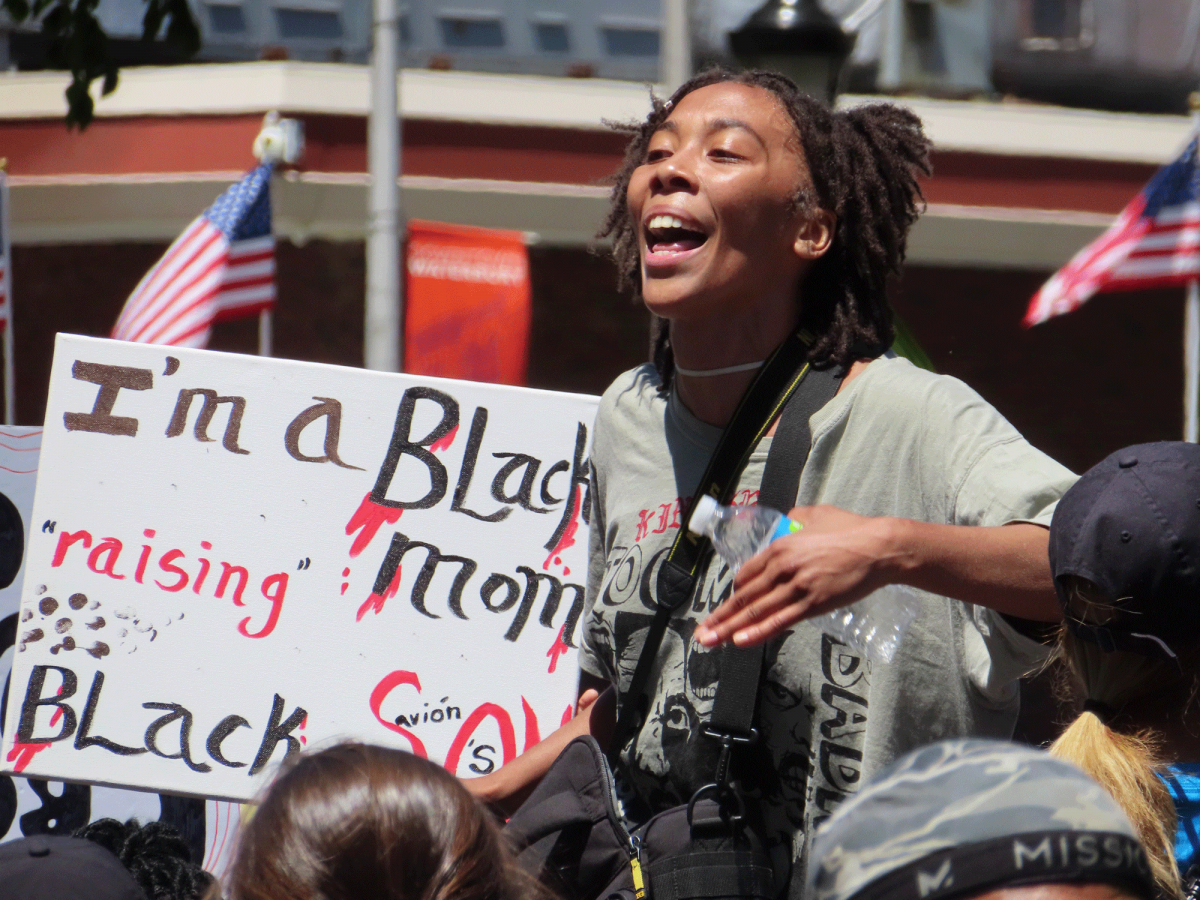
Back at the Green a second rally unfurled complete with a new megaphone and roster of speakers. Many Waterbury residents believed it was a continuation of the the first protest – it wasn’t.
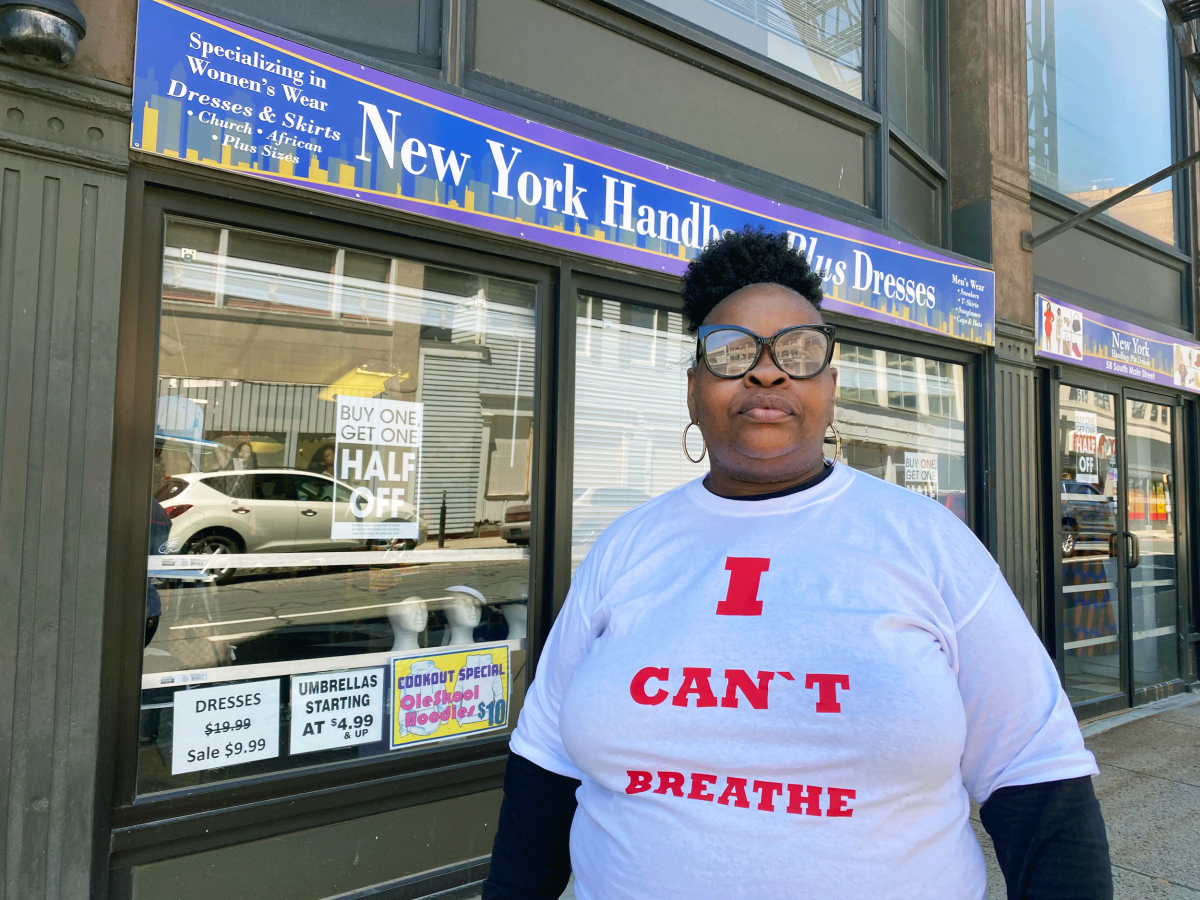
Waterbury business owner Joyce Reid was uncomfortable with elements of the march up to the Waterbury Police Station. Something changed, she said, it wasn’t Waterbury people leading anymore. She didn’t like the tone of the march and broke off to protect her small business on South Main Street. “I’ve worked too hard to build my business,” she said, “and I’m not going to let anyone from out of town mess with my store.”
After staging a rally on the Green the protesters marched back to the police station, up East Main Street, Meriden Road and to Wolcott Road. Chief Spagnolo said at one point protesters attempted to engage with an isolated cop when a group of Waterbury residents surrounded the officer. The residents protected the officer, Spagnolo said, “They said this is a good man. This is our city and we don’t do that here.”
Undercover police officers (planted in the march) reported that agitators were leading the protesters to Walmart on Wolcott Road to loot the megastore. Spagnolo said the situation was dangerously out of control and he ordered the police to set up a line at the intersection of Long Hill and Wolcott Road.
“We stopped them half a block from Walmart,” Spagnolo said. “The situation was out of control – a powder keg – the protesters had shut the city down and we had lost any ability to communicate with the group.”
The protesters marched into a wall of Waterbury police officers in full riot gear, with the mounted patrol and police dogs fully visible, and a standoff ensued. Police used a loud sound system to order the crowd to get off the road, and some did. After several warnings, with a group still standing defiantly in the road, the police began making arrests.

The afternoon turned violent as the Waterbury police blocked hundreds of marchers headed towards Walmart on Wolcott Road. Police developed intel that looting Walmart was an objective of outside agitators, and Police Chief Spagnolo was not going to let that happen.
After a wave of arrests Spagnolo ordered the police to show less signs of force, and the shields, masks, horses and dogs and most of the officers were removed, and the crowd dispersed. But the protesters weren’t through yet. They marched back to Police HQs for more confrontation. They yelled, swore and heckled the police, and another 18 protesters were arrested on East Main Street. There were 28 arrests during the protests, 19 from Waterbury and 9 from out of town.
“We had all of our African-American officers on duty to help calm the crowd and communicate with people they knew,” Spagnolo said, “and many of the officers came under personal attack.”
At headquarters the police used the same tactics they did on Wolcott Road with a heavy show of force, arrest trespassers onto East Main Street, and then scale back the show of force. When the Observer arrived at HQs to cover the event there were 50 police officers in front of the building. Within thirty minutes there were three officers, and by 8 pm the crowd of 200 dwindled down to 30 hard core protesters who sat close together and shared boxes of pizza.

After dispersing the marchers on Wolcott Road the protesters returned to police headquarters on East Main Street to continue the confrontation.

Throughout the afternoon conversations between city residents and police officers erupted – some civil, and some vulgar and vile.
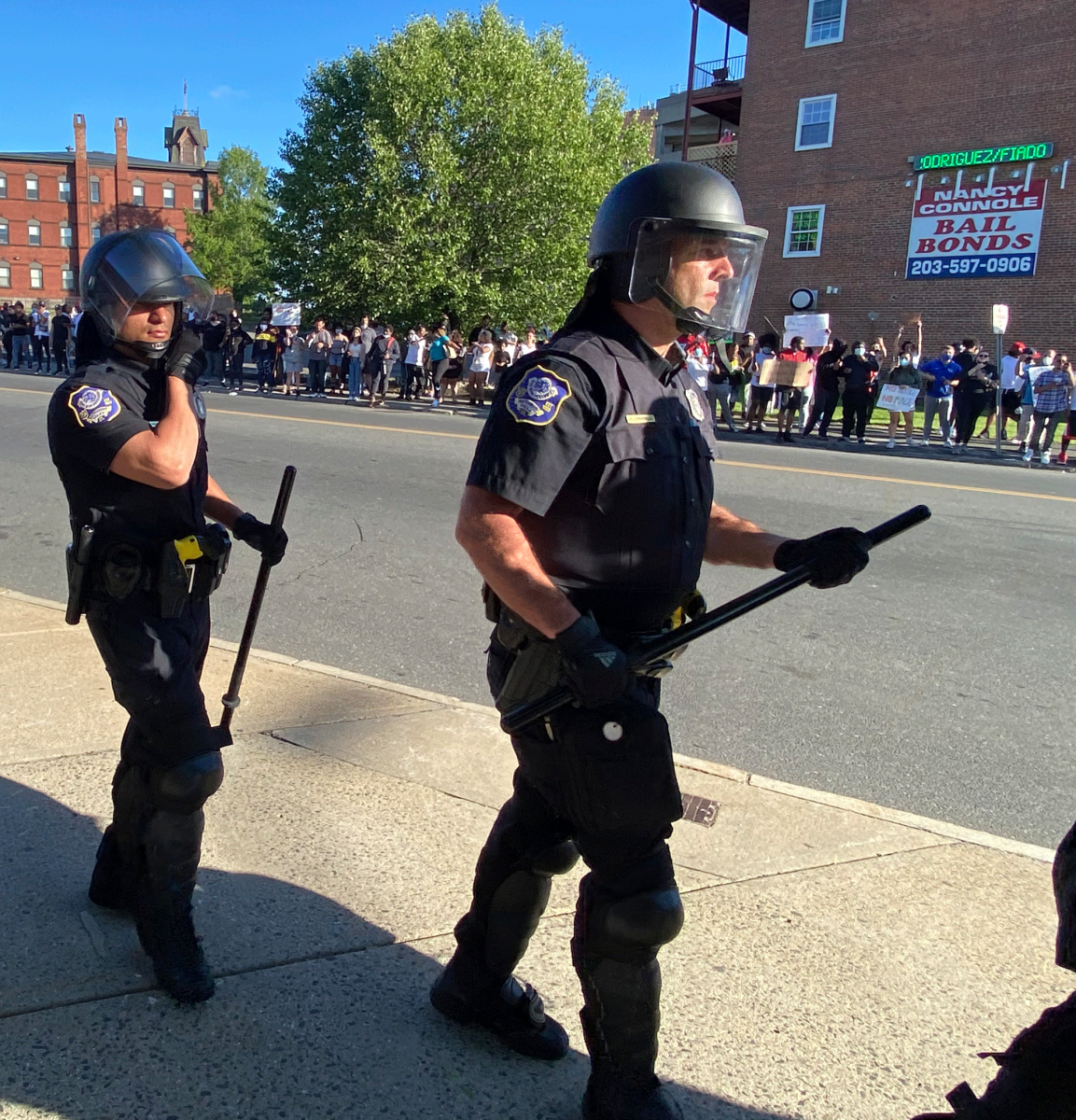
The sight of police in riot gear using mounted horses and dogs to control protesters was a shock to many residents, but Chief Spagnolo defended the actions as necessary to quell a dangerous situation.
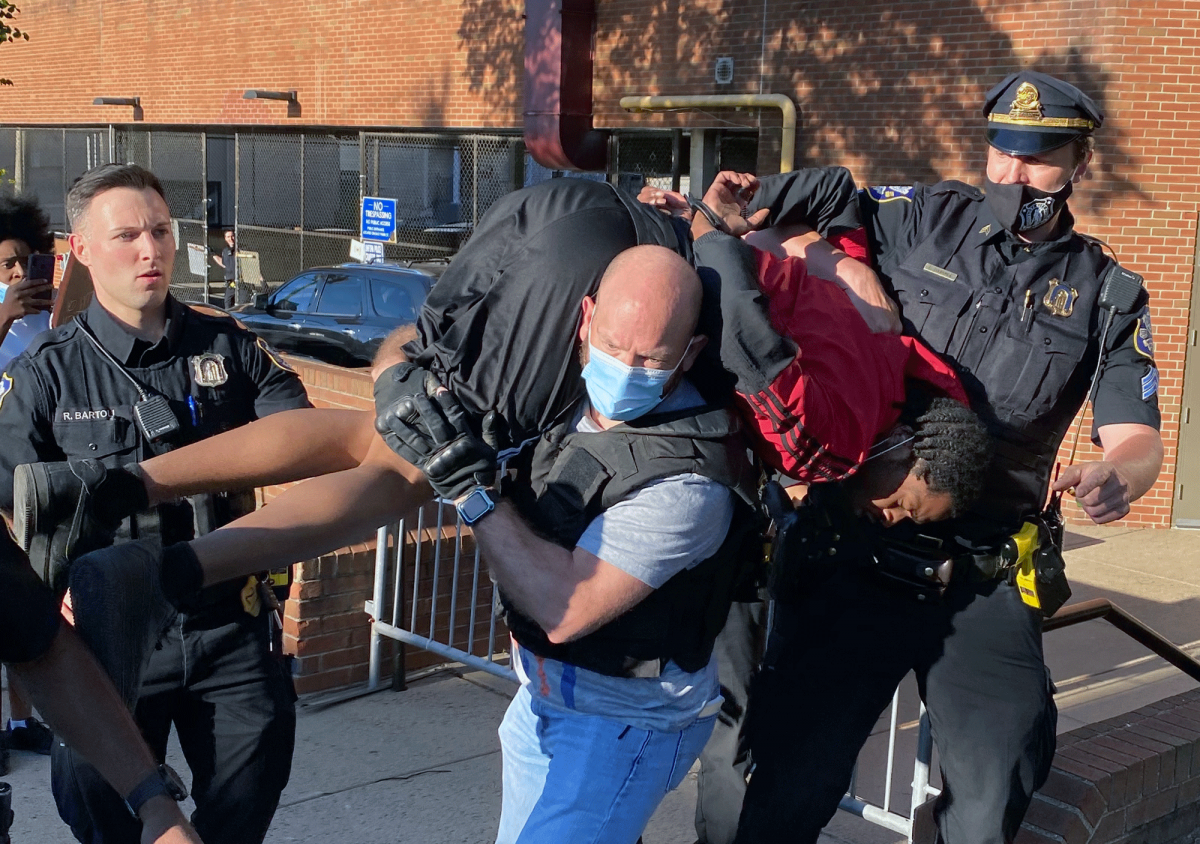
A protester was caught after trying to outrun police officers, but when he went limp to pacifly resist arrest, a police officer picked him up and carried him towards the police station.
“The entire country is emotionally charged,” Spagnolo said. “America is wrestling with centuries of systemic racism and oppression and we are free falling over a cliff. We need to find common ground right now.”
Locally, Spagnolo said the biggest issue is that the black community doesn’t feel safe. “We have to find a way to make the black community feel safe,” he said. “Whether it’s body cameras or diversity commissions we have to address this right now. We need to openly acknowledge our country’s past, find common ground, and find a way forward.”
Spagnolo does not apologize for the show of force the police used on Wolcott Street or East Main Street. “It was a dangerous situation,” Spagnolo said. “Outside agitators were trying to incite confrontation with police officers and were going to loot Walmart. They had shut the city down and needed to be stopped.”
Several individuals have reached out directly to The Waterbury Observer complaining about unbalanced media coverage, including our own first attempt at covering the events. One young woman wrote, “People who were involved in the protest after the first part feel attacked. Some of them (many Waterbury citizens) didn’t even realize there was more than one part and thought it was one big thing. There were people who spoke to the police one on one and had different experiences. There were people that were arrested who were trying to keep peace within the crowd. Do you see how reading an article that simply portrays them as opportunists & outside agitators would make them feel slighted?”
She said they felt “unheard”, and in the days ahead the Observer hopes to engage residents who marched out onto the highway, up Wolcott Road and engaged with Waterbury police. Their stories are important to acknowledge and record, and we will do that.
Mayor Neil O’Leary has promised to form a diversity council to explore concerns of racial inequity in all facets of city government and schools, and he hosted a televised community discussion on June 1st called, “Community Conversation on Current Events, Relationships and Solidarity”. The program included Governor Ned Lamont, Senator Chris Murphy, Congresswoman Jahana Hayes, Spagnolo, O’Leary and a dozen community leaders. Mayor O’Leary has asked anyone interested in joining the council to register interest by calling his office at 203-574-6712.
Despite the chaos that spread through the city in the afternoon and evening, West and Eason will continue to explore ways to directly communicate with the Waterbury Police Department and elected officials to enact change. West has already expressed an interest in being on the diversity council.

Jalia West and Alexa Eason organized a peaceful and non-violent protest, one of the best in city history.
Ending on a more promising note, it seems that in despite of the actions incited by outside agitators, West and Eason’s protest has inspired a renewed sense of urgency to redress racial injustices in Waterbury.
Harking back to Rev. Jackson’s question about whether the police stand with or against the movement, Chief Spagnolo said he stands beside their cause and recognizes the severity of the problem from coast to coast.
“We understand, and we empathize with the situation that’s going on around this country,” Spagnolo said. “And we want to help resolve it.”

